Gathering material for articles here at TFB is a mixture of results for this senior scribe, ranging from full exultation to sheer deception. Sometimes an interesting photo negative is dug out from surviving files, just for yours truly to find out that no related info is located in his somewhat messy files. The other way around is, of course, sometimes the case: data, but no photo! But there’s another variation in the process: the case of both pics and info duly located, but in such a limited form that they become too narrow to generate a full story. Here’s what I mean, hoping you enjoy:



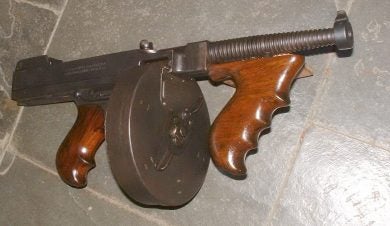
What about a bunch of “shorty” .45 ACP M1928 Thompson submachine guns, to start? The story goes here in Brazil that they were so modified by Brazilian Army’s AGRJ – Arsenal de Guerra do Rio de Janeiro (Rio de Janeiro War Arsenal) to be used by the bodyguard detail of President Getúlio Vargas in the early 1950s. But another story also goes that they came up sometime in the early 1970s when President Emílio Médici was in the office. Maybe we’ll never know, but here are some photos.

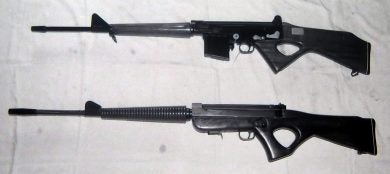
When IMBEL – Indústria de Material Bélico do Brasil S.A. was playing around with .22 LR FAL rifles in the early 1980s, the staff of the Prototypes Workshop of its Fábrica de Itajubá came out with the two guns shown in photos. They were apparently intended to be offered in the U.S. market (see the “non-aggressive” thumbhole stocks and long barrels) through Springfield Armory, but negotiations did not materialize into a firm program.
It should be recalled, on the other hand, that IMBEL eventually became a major exporter of guns to the United States through the Springfield Armory way. These included both 7.62x51mm semi-auto FAL rifles (full weapons and parts) and M1911A1-type pistols, and went on in a most successful way in the 1985-2011 period. The Brazilian-made metric FALs (Springfield SAR-48s and SAR-4800s) proved to be highly praised items in the U.S. market, while receivers and barrels were also marketed by Century Arms and Pacific Sporting Arms. Even more successful was the semi-auto pistol part of the venture, which resulted in the sale of over 500,000 guns, most .45 ACP M911A1 types, with the highest yearly record being over 40,000 units in 2007 alone.
Another bi-national joint venture, however, did not fully complete. Remember the ugly, but entirely functional, dual 14-in barrel/caliber USAF M6 Air Crew Survival Weapon of the 1960s-70s? And that it was later sold by Springfield Armory as the M6 Scout, with law-abiding 18+in barrels?
Well, it just so happened that the guns were actually made by CZ in (then) Czechoslovakia, but there was an attempt to have them manufactured in Brazil by IMBEL, as well. This appears to have taken place in the late 1990s or so, with a batch of at least 50 examples having been completed by Fábrica de Itajubá, in Minas Gerais State. For unknown reasons, they were never delivered to the American company, and most guns ended up in collectors’ hands after public auctions in 2001-2002. I’ve brought two of them to your view in exclusive photos kindly supplied by my friend Mauro Pellegrini:

A very early M6 Scout made by Fábrica de Itajubá. Markings on right side of receiver read: “ARMA DE CAÇA BASCULANTE DE CANOS SUPERPOSTOS – IMBEL – MD1 – CAL .22LR e 36 (410”) – PROTÓTIPO No 02A”.

Left side view of the same “02A” prototype gun, sporting the IMBEL logo and the markings “IMBEL – FÁBRICA DE ITAJUBÁ – BRASIL” on the receiver.
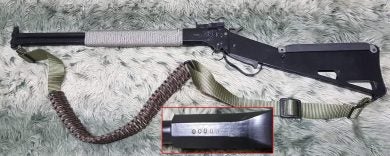
The current owner of “00003” made by Fábrica de Itajubá has given it a smart paracord handguard and a fancy sling. Inset shows the construction number markings on barrel underside, below chamber.
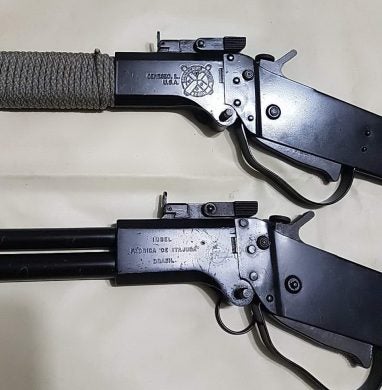
Shown together with the “02A” prototype, “00003” (top) sports the Springfield Armory logo and address.

The right-side markings on “00003” read “SPRINGFIELD ARMORY – M6 SURVIVAL – .22LR/.410 SHOTGUN”, no actual manufacturer reference being found anywhere. “02A” prototype is below.
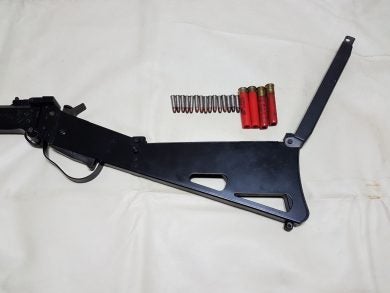
The ammo compartment (in stock) of Brazilian-made M6 Survival Gun “00003” is open to show its current “survival” load: 15 .22LR CCI Stinger rounds, two .410 birdshot shells, and two .410 rifled slugs.


Sometime in the 1950s, the Argentine Army started considering adopting a semi-automatic rifle to replace its bolt-action 7.65x54mm-chambered Mauser M1909s in use since the early 20th Century. One of the attempts was somewhat modifying the U.S. M1 Garand to fit the local needs and placing it in production in the country, an idea supposedly coming from the HAFDASA (Hispano-Argentina Fábrica de Automobiles S.A.) company, in Buenos Aires. What seems to have been the single prototype completed is shown in these photos. It is relevant that the whole top handguard is machined aluminum with transversal ventilation cuts. All other details are unknown, and this includes the proposed caliber.

Just for the historical record, here are three 7.65x54mm Mauser Modelo Argentino 1909 guns (top to bottom): Infantry Rifle, Cavalry Carbine, and Engineers Carbine. Altogether, about 130,000 examples were acquired in the 1909-1911 period.
 Your Privacy Choices
Your Privacy Choices
